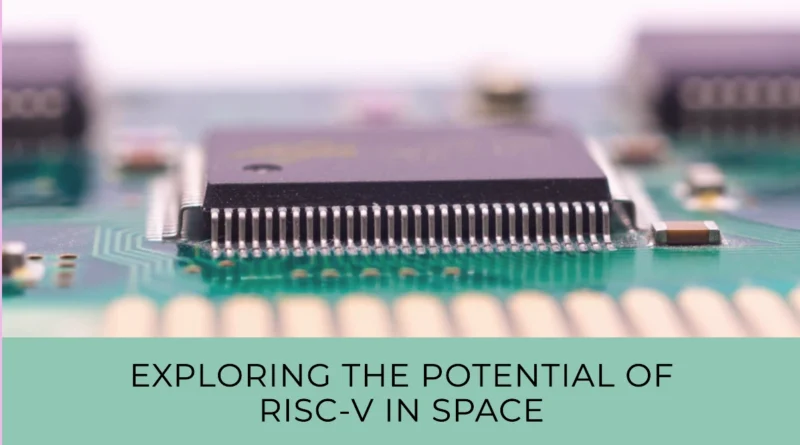Unleashing the Power of RISC-V in Space: The Era of Cubesats
In the ever-evolving landscape of space technology, cubesats have emerged as miniature workhorses for scientific research, data collection, and more. These tiny satellites, often no larger than a shoebox, have been instrumental in expanding our understanding of the cosmos. Now, there’s a new player in town: RISC-V, an open-source Reduced Instruction Set Computer (RISC) architecture. In this blog, we’ll explore how RISC-V is making its mark in the world of cubesats, revolutionizing the way we approach space exploration.
Understanding Cubesats: Small but Mighty
Before we delve into the role of RISC-V in cubesats, let’s first understand what cubesats are and why they are significant.
What are Cubesats?
Cubesats are a class of small satellites that have gained popularity in recent years. They are characterized by their standardized size and modular design, typically measuring 10 x 10 x 10 centimeters (hence the name “cubesat”). These miniaturized spacecraft have opened up new possibilities in space research and exploration due to their cost-effectiveness and versatility.
The Versatility of Cubesats
Cubesats come in various sizes, known as “U-class” cubesats. They can be 1U (10 x 10 x 10 cm), 2U (10 x 10 x 20 cm), 3U, and so on, with 6U and 12U cubesats being common as well. Despite their small stature, cubesats have proven their worth in a wide range of applications, including:
- Earth Observation: Cubesats equipped with cameras and sensors are used to monitor our planet’s climate, weather, and natural disasters.
- Astronomical Observation: These tiny observatories peer into the depths of space, capturing images of distant galaxies, stars, and celestial phenomena.
- Scientific Experiments: Cubesats enable scientists to conduct experiments in microgravity environments, advancing our knowledge in various scientific disciplines.
- Communications: Some cubesats serve as relays for data communication in remote regions of the world.
- Education: Cubesats provide valuable hands-on experience for students and researchers in aerospace engineering and space science.
Now, let’s turn our attention to RISC-V and how it’s poised to enhance the capabilities of these miniature space explorers.
RISC-V: The Open-Source Revolution
What is RISC-V?
RISC-V is an open-source instruction set architecture (ISA) rooted in the principles of Reduced Instruction Set Computing (RISC). Unlike proprietary ISAs, RISC-V is freely available, allowing anyone to design, build, and customize processors based on this architecture.
The Advantages of RISC-V
Why is RISC-V gaining traction in various computing domains, including space technology? Let’s explore its key advantages:
| Advantages of RISC-V |
| 1. Simplicity: RISC-V processors execute a limited set of simple instructions, streamlining instruction execution for enhanced performance. |
| 2. Open-Source: RISC-V’s open nature fosters innovation and collaboration, making it an attractive choice for developers and researchers. |
| 3. Customization: Users can tailor RISC-V processors to meet specific application requirements, optimizing performance and energy efficiency. |
| 4. Scalability: RISC-V supports various instruction set widths, allowing for scalability and adaptability in different computing environments. |
These advantages make RISC-V a compelling option for a wide range of applications, and now, it’s finding its way into the world of cubesats.
RISC-V Meets Cubesats: The Trikarenos Chip
The Trikarenos Chip: A Game Changer for Cubesats
Recently, a team of researchers proposed using a RISC-V-based microcontroller chip called Trikarenos to power cubesats. What sets this chip apart, and how does it address the unique challenges of space?
| Trikarenos Chip Highlights |
| 1. RISC-V Architecture: Trikarenos leverages the RISC-V ISA, known for its simplicity and efficiency, making it well-suited for cubesat applications. |
| 2. Fault-Tolerant Design: Space is a harsh environment, and cubesats face radiation and other challenges. Trikarenos incorporates fault-tolerant features to ensure reliable operation in space. |
| 3. TSMC’s 28nm Process Tech: The chip is manufactured using TSMC’s advanced 28nm process technology, striking a balance between performance and power efficiency. |
Why RISC-V for Cubesats?
The integration of RISC-V into cubesats holds significant promise. Here’s why RISC-V is a game-changer for these miniature satellites:
| RISC-V Benefits for Cubesats |
| 1. Efficiency: RISC-V’s reduced instruction set ensures efficient use of computing resources, vital for resource-constrained cubesats. |
| 2. Customization: Cubesat missions vary widely. RISC-V’s customizable nature allows developers to tailor the processor to specific mission requirements. |
| 3. Open Collaboration: RISC-V’s open-source philosophy promotes collaboration among space enthusiasts, researchers, and developers, fostering innovation. |
RISC-V in Action: Cubesat Missions
Let’s explore some real-world examples of how RISC-V is making an impact in cubesat missions.
Earth Observation with RISC-V-Powered Cubesats
Cubesats equipped with RISC-V processors have been instrumental in Earth observation missions. These tiny satellites capture high-resolution images of our planet, monitor weather patterns, and track environmental changes. RISC-V’s efficiency plays a crucial role in processing and transmitting this data back to Earth.
| Cubesat Mission Example: Earth Observation |
| Mission: SkyWatch Earth Observation Cubesat |
| RISC-V Processor: Trikarenos |
| Objective: Capture high-resolution images of Earth for environmental monitoring and disaster management. |
| Impact: Improved data collection and transmission capabilities, enabling timely response to natural disasters. |
Exploring the Cosmos with RISC-V
Cubesats equipped with RISC-V processors are not limited to Earth-centric missions. They also venture into the depths of space to study distant celestial objects. These missions benefit from RISC-V’s adaptability and fault tolerance, ensuring reliable operation in the harsh space environment.
| Cubesat Mission Example: Astronomical Observation |
| Mission: StarGaze Cubesat |
| RISC-V Processor: Trikarenos |
| Objective: Observe distant galaxies and stars to unravel the mysteries of the universe. |
| Impact: Advancing our understanding of cosmic phenomena, contributing to astronomical research. |
Advancing Scientific Research with RISC-V
Cubesats are not just passive observers; they actively contribute to scientific research. RISC-V-powered cubesats conduct experiments in microgravity, enabling breakthroughs in various scientific disciplines. RISC-V’s customization capabilities ensure that these cubesats are equipped with the right tools for their specific experiments.
| Cubesat Mission Example: Scientific Experiments |
| Mission: BioLab Cubesat |
| RISC-V Processor: Trikarenos |
| Objective: Conduct biological experiments in microgravity to study the effects of space on living organisms. |
| Impact: Advancement in space medicine and biology, contributing to our knowledge of human health in space. |
The Future of RISC-V and Cubesats
As we look to the future, the collaboration between RISC-V and cubesats promises to unlock even more possibilities in space exploration. Researchers, engineers, and space enthusiasts are coming together to harness the potential of open-source RISC-V processors in cubesat missions.
Key Trends and Developments
Let’s explore some key trends and developments in the ever-evolving relationship between RISC-V and cubesats:
| Trends in RISC-V and Cubesats |
| 1. Miniaturization: Continued miniaturization of RISC-V processors and cubesat components, allowing for more sophisticated payloads and experiments. |
| 2. AI and Machine Learning: Integration of AI and machine learning capabilities into cubesats, enabled by efficient RISC-V processors. |
| 3. Interplanetary Exploration: RISC-V-powered cubesats could play a role in interplanetary exploration, with missions to Mars and beyond on the horizon. |
| 4. Global Collaboration: Increased collaboration among space agencies, universities, and commercial entities to leverage RISC-V for cubesat missions. |
Conclusion: RISC-V and Cubesats – A Stellar Combination
In the realm of space exploration, innovation knows no bounds. Cubesats have already proven their worth as versatile tools for scientific research and data collection. With the integration of RISC-V processors like Trikarenos, cubesats are poised to reach new heights, literally and figuratively.
The open-source nature of RISC-V, coupled with its simplicity and efficiency, makes it an ideal choice for cubesat missions. Whether it’s Earth observation, astronomical exploration, or scientific experiments, RISC-V-powered cubesats are making significant contributions to our understanding of the cosmos.
As we continue to push the boundaries of space technology, the collaboration between RISC-V and cubesats serves as a shining example of what can be achieved when innovation and open collaboration intersect. Together, they are helping us unravel the mysteries of the universe, one tiny satellite at a time.
In the words of Carl Sagan, “Somewhere, something incredible is waiting to be known.” With RISC-V and cubesats leading the way, we are on an incredible journey of discovery, exploring the vast expanse of space like never before.
Sources:




